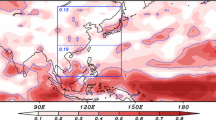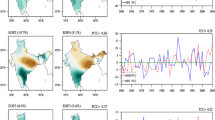Abstract
The part II of the present study focuses on northern East Asia (NEA: 26°N–50°N, 100°–140°E), exploring the source and limit of the predictability of the peak summer (July–August) rainfall. Prediction of NEA peak summer rainfall is extremely challenging because of the exposure of the NEA to midlatitude influence. By examining four coupled climate models’ multi-model ensemble (MME) hindcast during 1979–2010, we found that the domain-averaged MME temporal correlation coefficient (TCC) skill is only 0.13. It is unclear whether the dynamical models’ poor skills are due to limited predictability of the peak-summer NEA rainfall. In the present study we attempted to address this issue by applying predictable mode analysis method using 35-year observations (1979–2013). Four empirical orthogonal modes of variability and associated major potential sources of variability are identified: (a) an equatorial western Pacific (EWP)-NEA teleconnection driven by EWP sea surface temperature (SST) anomalies, (b) a western Pacific subtropical high and Indo-Pacific dipole SST feedback mode, (c) a central Pacific-El Nino-Southern Oscillation mode, and (d) a Eurasian wave train pattern. Physically meaningful predictors for each principal component (PC) were selected based on analysis of the lead–lag correlations with the persistent and tendency fields of SST and sea-level pressure from March to June. A suite of physical–empirical (P–E) models is established to predict the four leading PCs. The peak summer rainfall anomaly pattern is then objectively predicted by using the predicted PCs and the corresponding observed spatial patterns. A 35-year cross-validated hindcast over the NEA yields a domain-averaged TCC skill of 0.36, which is significantly higher than the MME dynamical hindcast (0.13). The estimated maximum potential attainable TCC skill averaged over the entire domain is around 0.61, suggesting that the current dynamical prediction models may have large rooms to improve. Limitations and future work are also discussed.












Similar content being viewed by others
References
Chowdary JS, Xie SP, Lee JY, Kosaka Y, Wang B (2010) Predictability of summer northwest Pacific climate in 11 coupled model hindcasts: local and remote forcing. J Geophys Res 115:D22121. doi:10.1029/2010JD014595
Chowdary JS, Xie SP, Luo JJ, Hanfner J, Behera S, Masumoto Y, Yamagata Y (2011) Predictability of Northwest Pacific climate during summer and the role of the tropical Indian Ocean. Clim Dyn 36:607–621. doi:10.1007/s00382-009-0686-5
Dee DP et al (2011) The ERA-interim reanalysis: configuration and performance of the data assimilation system. Q J R Meteorol Soc 137:553–597
DelSole T, Shukla J (2009) Artificial skill due to predictor screening. J Clim 22:331–345
Delworth TL, Broccoli AJ, Rosati A et al (2006) GFDL’s CM2 global coupled climate models. Part I: formulation and simulation characteristics. J Clim 19:643–674
Ding Q, Wang B (2005) Circumglobal teleconnection in the Northern Hemisphere Summer. J Clim 18:3483–3505
Du Y, Xie SP, Huang G, Hu K (2009) Role of air-sea interaction in the long persistence of El Nino-induced North Indian Ocean warming. J Clim 22:2023–2038
Enomoto T, Hoskins BJ, Mastuda Y (2003) The formation mechanism of the Bonin high in August. Q J R Meteorol Soc 129:157–178
Gill AE (1980) Some simple solutions for heat-induced tropical motion. Q J R Meteorol Soc 106:447–462
Gong DY, Yang J, Kim SJ, Gao Y, Guo D, Zhou T, Hu M (2011) Spring Arctic Oscillation-East Asian summer monsoon connection through circulation changes over the western North Pacific. Clim Dyn 37:2199–2221
Hudson D, Alves O, Hendon HH, Wang G (2010) The impact of atmospheric initialisation on seasonal prediction of tropical Pacific SST. Clim Dyn 36:1155–1171
Huffman GJ, Adler RF, Bolvin DT, Gu G (2009) Improving the global precipitation record: GPCP version 2.1. Geophys Res Lett 36(17):L17808. doi:10.1029/2009GL040000
Lau NC, Nath MJ, Wang H (2004) Simulations by a GFDL GCM of ENSO-related variability of the coupled atmosphere-ocean system in the East Asian monsoon region. In Chang CP (ed) East Asian monsoon, World Scientific series on meteorology of East Asia No. 2, World Scientific, Singapore, pp 271–300
Li B, Zhou T (2011) ENSO-related principal interannual variability modes of early and late summer rainfall over East Asia in SST-driven AGCM simulations. J Geophys Res 116(D14118):1–15
Lin ZD, Wang B (2015) Northern East Asian low and its impact on interannual variation of East Asian summer rainfall. Clim Dyn. doi:10.1007/s00382-015-2570-9
Lu R, Dong B, Ding H (2006) Impact of the Atlantic Multidecadal Oscillation on the Asian summer monsoon. Geophys Res Lett 33:L24701. doi:10.1029/2006GL027655
Luo JJ, Masson S, Behera S, Shingu S, Yamagata T (2005) Seasonal climate predictability in a coupled OAGCM using a different approach for ensemble forecast. J Clim 18:4474–4497
Michaelsen J (1987) Cross-validation in statistical climate forecast model. J Clim Appl Meteorol 26:1589–1600
Nitta T (1987) Convective activities in the tropical western Pacific and their impact on the Northern Hemisphere summer circulation. J Meteorol Soc Jpn 65:373–390
North GR, Bell TL, Cahalan RF, Moeng FJ (1982) Sampling errors in the estimation of empirical orthogonal functions. Mon Weather Rev 110(7):699–706
Ogi M, Tachibana Y, Yamazaki K (2004) The connectivity of the winter North Atlantic Oscillation (NAO) and the summer Okhotsk High. J Meteorol Soc Jpn 82:905–913
Panofsky HA, Brier GW (1968) Some applications of statistics to meteorology. Pennsylvania State University Press, Pennsylvania
Saha S et al (2010) The NCEP climate forecast system reanalysis. Bull Am Meteorol Soc 91(8):1015–1057. doi:10.1175/2010BAMS3001.1
Smith TM, Reynolds RW (2003) Extended reconstruction of global sea surface temperatures based on COADS data (1854–1997). J Clim 16:1495–1510
Wang B, Zhang Q (2002) Pacific-East Asian teleconnection, part II: how the Philippine Sea anticyclone established during development of El Nino. J Clim 15:3252–3265
Wang B, Wu R, Fu X (2000) Pacific-East Asia teleconnection: how does ENSO affect East Asian climate? J Clim 13:1517–1536
Wang B, Ding Q, Fu X, Kang IS, Jin K, Shukla J, Doblas-Reyes F (2005) Fundamental challenge in simulation and prediction of summer monsoon rainfall. Geophys Res Lett 32(15):L15711. doi:10.1029/2005GL022734
Wang B, Lee JY, Kang IS, Shukla J, Hameed SN, Park CK (2007) Coupled predictability of seasonal tropical precipitation. CLIVAR Exch 12:17–18
Wang B, Bao Q, Hoskins B, Wu G, Liu Y (2008a) Tibetan Plateau warming and precipitation change in East Asia. Geophys Res Lett 35:L14702. doi:10.1029/2008GL034330
Wang B, Lee JY, Kang IS, Shukla J, Kug JS, Kumar A, Schemm J, Luo JJ, Yamagata T, Park CK (2008b) How accurately do coupled climate models predict the Asian-Australian monsoon interannual variability? Clim Dyn 30:605–619. doi:10.1007/s00382-007-0310-5
Wang B, Liu J, Yang J, Zhou T, Wu Z (2009) Distinct principal modes of early and late summer rainfall anomalies in East Asia. J Clim 22:3864–3875
Wang B, Xiang B, Lee JY (2013a) Subtropical High predictability establishes a promising way for monsoon and tropical storm predictions. PNAS 110:2718–2722
Wang B, Liu J, Kim HJ, Webster PJ, Yim SY, Xiang B (2013b) Northern Hemisphere summer monsoon intensified by mega-El Nino-Southern oscillation and Atlantic multidecadal oscillation. PNAS. doi:10.1073/pnas.1219405110
Wang B, Lee JY, Xiang B (2014) Asian summer monsoon rainfall predictability: a predictable mode analysis. Clim Dyn. doi:10.1007/s00382-014-2218-1
Wang B, Xiang BQ, Li J, Webster PJ, Rajeevan MN, Liu J, Ha KJ (2015) Rethinking Indian monsoon rainfall prediction in the context of recent global warming. Nat Commun 6:7154. doi:10.1038/ncomms8154
Wu Z, Li J (2008) Prediction of the Asian-Australian monsoon interannual variations with the grid-point atmospheric model of IAP LASG (GAMIL). Adv Atmos Sci 25(3):387–394
Wu Z, Wang B, Li J, Jin FF (2009a) An empirical seasonal prediction of the east Asian summer monsoon using ENSO and NAO. J Geophys Res 114:D18120. doi:10.1029/2009JD011733
Wu BY, Zhang RH, Wang B, D’Arrigo R (2009b) On the association between spring Arctic sea ice concentration and Chinese summer rainfall. Geophys Res Lett 36:L09501. doi:10.1029/2009GL037299
Xiang B, Wang B, Yu W, Xu S (2013) How can anomalous western North Pacific subtropical high intensify in late summer? Geophys Res Lett. doi:10.1002/grl.50431
Xing W, Wang B, Yim SY (2015) Peak-Summer East Asian Rainfall Predictability and Prediction Part I: Southeast Asia. Clim Dyn. doi:10.1007/s00382-014-2385-0
Yim SY, Jhun JG, Lu R, Wang B (2010) Two distinct patterns of spring Eurasian snow cover anomaly and their impacts on the East Asian summer monsoon. J Geophys Res 115:D22113. doi:10.1029/2010JD013996
Yim SY, Wang B, Xing W (2014) Prediction of early summer rainfall over South China by a physical-empirical model. Clim Dyn. doi:10.1007/s00382-013-2014-3
Yoo SH, Ho CH, Yang S, Choi HJ, Jhun JG (2004) Influences of tropical western and extratropical Pacific SST on east and southeast Asian climate in the summers of 1993–94. J Clim 17:2673–2687
Yuan Y, Yang S (2012) Impacts of different types of El Nino on East Asian climate: focus on ENSO cycles. J Clim 25:7702–7722. doi:10.1175/JCLI-D-11-00576.1
Zhang R, Sumi A, Kimoto M (1996) Impact of El Nino on the East Asian monsoon: a diagnostic study of the ’86/87 and ’91/92 events. J Meteorol Soc Jpn 74:49–62
Zhang YS, Li T, Wang B (2004) Decadal change of the spring snow depth over the Tibetan Plateau: the associated circulation and influence on the east Asian summer monsoon. J Clim 17(14):2780–2793
Zhao P, Wang B, Zhou XJ (2012) Boreal summer continental monsoon rainfall and hydroclimate anomalies associated with the Asian-Pacific oscillation. Clim Dyn 39:1197–1207. doi:10.1007/s00382-012-1348-6
Zhou TJ, Zou LW (2010) Understanding the predictability of East Asian summer monsoon from the reproduction of land-sea thermal contrast change in AMIP-type simulation. J Clim 23(22):6009–6026
Acknowledgments
This work was jointly supported by APEC climate center (APCC), the National Research Foundation (NRF) of Korea through a Global Research Laboratory (GRL) Grant of the Korean Ministry of Education, Science and Technology (MEST, #2011-0021927). BW acknowledges support form Atmosphere–Ocean Research Center (AORC) at UH supported by Nanjing University of Information Science and Technology. WX acknowledges support from NSFC-Shandong Joint Fund for Marine Science Research Centers (Grant No. U1406401). We also acknowledge support from the International Pacific Research Center (IPRC). This is publication No 069 of Earth System Modeling Center (ESMC).
Author information
Authors and Affiliations
Corresponding author
Rights and permissions
About this article
Cite this article
Yim, SY., Wang, B. & Xing, W. Peak-summer East Asian rainfall predictability and prediction part II: extratropical East Asia. Clim Dyn 47, 15–30 (2016). https://doi.org/10.1007/s00382-015-2849-x
Received:
Accepted:
Published:
Issue Date:
DOI: https://doi.org/10.1007/s00382-015-2849-x




